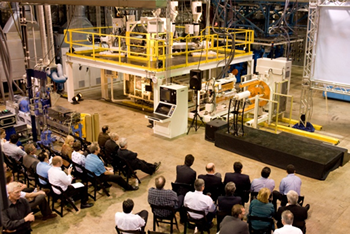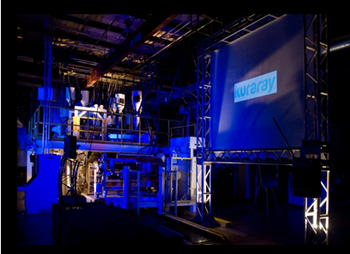 From 18-19 April 2011, I had the pleasure of attending the official ribbon-cutting ceremony and associated technical sessions for a very interesting new 21-layer cast film and sheet pilot line in Pasadena, Texas, USA. I can say that the event was interesting for a number of different reasons aside from the obvious attraction to state-of-the-art manufacturing equipment.
From 18-19 April 2011, I had the pleasure of attending the official ribbon-cutting ceremony and associated technical sessions for a very interesting new 21-layer cast film and sheet pilot line in Pasadena, Texas, USA. I can say that the event was interesting for a number of different reasons aside from the obvious attraction to state-of-the-art manufacturing equipment.
The EVAL™ Group of Kuraray is responsible for the production of Ethylene Vinyl Alcohol copolymer (EVOH), a random copolymer of ethylene and vinyl alcohol. EVOH, is a very high barrier material which possesses very robust characteristics in use and is particularly effective when employed as a coextruded layer with other materials. Specifically, EVOH can effectively block the transmission of a variety of permeants ranging from oxygen, nitrogen, carbon dioxide and helium to chlorinated or aromatic hydrocarbons and solvents. EVOH, I learned, may be considered by some as the saving grace for NIKE’s air-sole technology; and it is responsible for providing flexible food packaging the ability to stabilize flavor and reduce oxidation. Because EVOH can help film systems to achieve all of this, it is also directly responsible for a move to lower carbon-footprint packaging and lower production costs of films.
The application areas and methods for incorporating EVOH in various film systems continues to evolve due in great part to the commitment of the EVAL™ Group to support R&D and partner with its clients to innovate. This couldn’t be more clear than when you look at the new pilot line. This state-of-the-art cast film and sheet pilot line has 5 extruders capable of producing complex films ranging in thickness from 5 to 60 mils and comprised of up to 21 layers. In fact, these complex films may have up to 17 nano-layers™ at their core. As demonstrated by Oliver Catherine from Cloernen Inc., the use of nano-layers™ provides multiple benefits. First, there is a capability to combine a variety of materials each with different properties, which yields multi-purpose hybrid materials that possess the strengths of each of their respective components. Equally as promising is the ability of the nano-layer to create strengths. Specifically, it was demonstrated that a reduction of EVOH layer thickness can achieve a targeted crystalline structure which supports barrier function, improving significantly various material properties like stress-crack resistance.
 All of this is wonderful, but what does it mean for geosynthetics? EVOH is potentially very important to waste containment applications and ultimately the environment. EVOH’s proven ability to retard the transmission of volatile organic compounds (VOCs) through a membrane barrier can potentially give geomembranes the ability to provide significant environmental protection. The fuel tank industry has been successfully employing EVOH in this regard for years and early studies at the Geosynthetic Research Institute show that this technology can be successfully utilized to block the transmission of VOCs when coextruded to create a HBGM or High Barrier Geomembrane.
All of this is wonderful, but what does it mean for geosynthetics? EVOH is potentially very important to waste containment applications and ultimately the environment. EVOH’s proven ability to retard the transmission of volatile organic compounds (VOCs) through a membrane barrier can potentially give geomembranes the ability to provide significant environmental protection. The fuel tank industry has been successfully employing EVOH in this regard for years and early studies at the Geosynthetic Research Institute show that this technology can be successfully utilized to block the transmission of VOCs when coextruded to create a HBGM or High Barrier Geomembrane.
There is no question that traditional monomer type geomembranes provide little or no protection against VOC transmission. For instance the volumetric permeation rate1 of Methane through for high-density polyethylene (HDPE)2 is about 2845 while a 32mol% of EVOH delivers a permeation rate of only 0.43. There have been simple questions raised, however, about the need or demand on systems to provide containment of VOCs. In fact, this is an emerging topic, one that is getting attention by researchers world-wide — projects are being conducted both at CEMAGREF (France) by Dr. Nathalie Touze-Foltz’s team and at Queen’s University (Canada) by Dr. Kerry Rowe and Rebecca McWatters. In addition there are other forward moving concepts which really justify further investigation into the potential benefits of this technology. When we talk about methane it’s difficult not to think of landfill gas emissions. In a recent paper Donald Hullings4 concluded that the most significant impact on carbon footprint by landfills occurs during the active time of the landfill, when it has open "uncovered" cells. He further asserts: “In a broader view, using geosynthetics during landfill filling to enhance gas collection and constructing a geomembrane cover to contain gases after filling are the critical elements to reduce emissions.” Something to think about.
It is also quite conceivable that EVOH could provide geosynthetic materials benefits beyond the obvious. Can EVOH make our materials more robust in other areas, can we reduce the use of other components to the benefit of both economy and durability?
The Pasadena facility will likely never produce a directly salable product for the EVAL group (they supply a variety of EVOH raw materials); but, combined with their fascinating testing laboratory (Complete with Scanning Electron Microscope) the EVAL team has invested in helping their clients discover new technologies and refine existing practices. It certainly seems as though the geosynthetics industry — our clients, our materials and our economy could benefit from further investigation.
REFERENCES
1 Volumetric permeation rate in (cc.20µ/m2.day.atm) – Conditions: 23°C- 0% RH (ASTM D1434T)
2 Permeability Properties of Plastics and Elastomers, Massey 2nd Edition
3 ASTM D1434 at Kuraray Lab – 32mol% EVOH
4 The Sustainable Landfill Revisited. Donald E. Hullings and Hal S. Boudreau III, Jones Edmunds, Gainsville FL. Presented at GRI-24, Dallas, TX 2011
Elizabeth Peggs is the Managing Director of Geosynthetica. Contact Us Today!.











